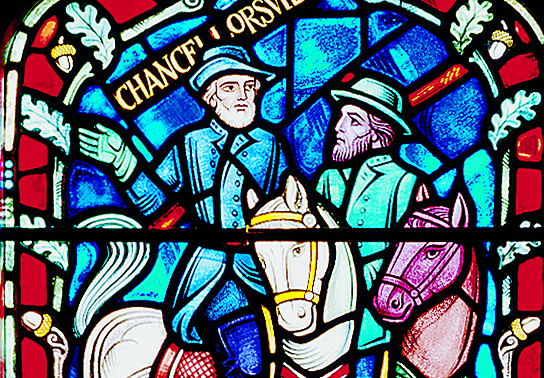Cathedral Loans Robert E. Lee Stained Glass Window to Smithsonian

Washington National Cathedral today announced that a stained glass window commemorating Confederate General Robert E. Lee has been loaned to the Smithsonian Institution’s National Museum of African American History and Culture as part of a temporary exhibit that examines the legacy of Reconstruction and the Lost Cause narrative.
The window, which was permanently removed from the Cathedral in 2017, will be on display through Aug. 21, 2022, as part of the Museum’s exhibit, “Make Good the Promises: Reconstruction and Its Legacies,” which features more than 175 objects, 300 images and 14 interactive media programs
- Read more about the new “Make Good the Promises” exhibit from the National Museum of African American History and Culture
- Learn more about the Cathedral’s removal and ongoing reckoning with the Lee-Jackson windows
When the exhibit ends in August 2022, the stained glass window will return to the Cathedral, where it will be conserved and stored. The window, along with a companion window that commemorated Confederate Gen. Thomas “Stonewall” Jackson, was deconsecrated and will remain away from public view.
The Very Rev. Randolph Marshall Hollerith, Dean of the Cathedral, explained that while the window no longer is part of the Cathedral’s sacred fabric, he hopes it can nonetheless help educate the public about our country’s racist past and point all Americans toward a more just and inclusive future.
From Dean Hollerith:
“The ongoing work of creating what Dr. King called the Beloved Community requires a commitment to an honest examination of our past and our present in order to create a better and more equitable future. In 2016, following the tragic shooting at Emanuel AME Church in Charleston, S.C., this Cathedral created a commission to consider the future of two stained-glass windows depicting Confederate Generals Robert E. Lee and Stonewall Jackson. This task force spent two years in deep study, conversation and prayer. Following the ugly and violent ‘Unite the Right’ rally in Charlottesville, Va. in 2017, Cathedral leaders decided to remove the windows. It was clear that they were a barrier to the mission and ministry of this Cathedral, and prolonged the suffering caused by the nation’s original sin of racism and slavery.
In order to further a fuller understanding of the depth and extent of racism in this country, the Cathedral has agreed to temporarily loan the Robert E. Lee window to the National Museum of African American History and Culture in Washington, D.C., where it will be displayed in an exhibit that explores the myth of the “Lost Cause.” We sincerely hope that an honest examination of the painful legacy represented in these windows will help all Americans forge a clearer understanding of our past. Looking to our future, we are committed to working to help unite this country around a shared identity of inclusion, equality and true justice for all.
Just as the past is never truly past, our work toward a more perfect Union is never truly complete. By removing these windows, the Cathedral took the first step among many toward telling a more accurate story about who we have been, who we are now, and most importantly who we aspire to be. While it is on loan to the Smithsonian, we hope this window can educate the public and move us all a bit closer toward healing the wounds of racism.”
Media Contacts:
Washington National Cathedral
Tony Franquiz, 202-374-5393
Cathedral@westendstrategy.com
National Museum of African American History and Culture
Fleur Paysour, 202-633-4761
paysourf@si.edu
http://newsdesk.si.edu
About Washington National Cathedral
Grounded in the reconciling love of Jesus Christ, Washington National Cathedral is a house of prayer for all people, conceived by our founders to serve as a great church for national purposes.
###
About the National Museum of African American History and Culture
On September 24, the National Museum of African American History and Culture (NMAAHC) will debut a new exhibition exploring an often-overlooked period of history, the Reconstruction Era. “Make Good the Promises: Reconstruction and Its Legacies,” featuring more than 175 objects, 300 images and 14 interactive media programs, will be on view until Aug. 21, 2022, in the museum’s 4,300-square-foot Bank of America Special Exhibitions Gallery. This exhibition and the release of its companion book form the centerpiece of activities celebrating the fifth anniversary of the opening of the museum.
In the aftermath of the Civil War, more than four million newly freed African Americans struggled to define themselves as equal citizens – to own land, to vote, to work for fair wages, build safe communities, educate themselves, and to rebuild families torn apart by slavery. Their aim during this period of Reconstruction was to live in a nation that kept the promises laid out in the U.S. Constitution. Not everyone celebrated the end of slavery. Many responded with violence ranging from unlawful incarceration and voter intimidation to lynchings and mass shootings. These are the legacies of Reconstruction.
###